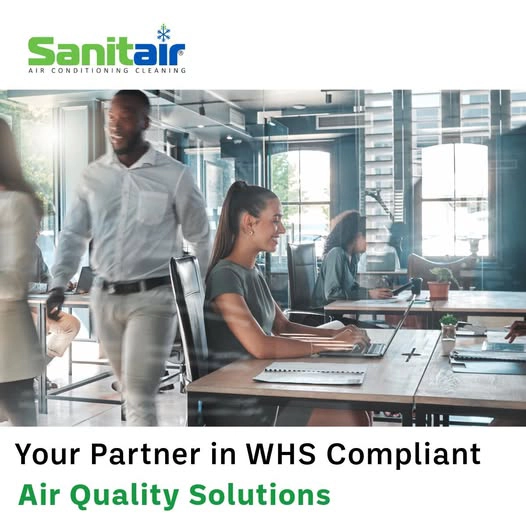
Ensuring workplace health and safety (WHS) through air quality compliance is crucial for Australian businesses, and partnering with Sanitair offers a trusted solution. Sanitair services Australia wide, providing expert air quality management to help organisations meet stringent WHS regulations and relevant codes.
Sanitair’s team of qualified HVAC hygienists specialises in commercial HVACHygiene and comprehensive mould removal. Sanitiair's expertise ensures workplaces remain compliant with the Work Health and Safety Act 2011 and exposure standards set by Safe Work Australia. These measures protect employees from harmful airborne contaminants and support legal compliance.
Under the Work Health and Safety (WHS) Act 2011 and associated regulations, persons conducting a business or undertaking (PCBUs) must ensure that airborne contaminants in the workplace do not exceed exposure standards, known as Workplace Exposure Standards (WES). These standards set limits on concentrations of various airborne chemicals and contaminants to prevent health risks for workers.
Sanitair, a leader in commercial air conditioning cleaning and sanitising, offers expertise to maintain clean, healthy air free from mould and other contaminants, helping businesses comply with these WHS air quality regulations. Their services include hygiene processes aligned with relevant Australian standards and codes, critical for compliance and optimal indoor air quality.
Key Australian standards and codes relevant to WHS air quality compliance include:
- The Work Health and Safety Act 2011 and WHS Regulations and Codes of Practice, which establish duties for risk management regarding airborne hazards.
- National Construction Code (NCC) Volume One – Building Code of Australia (BCA), which includes indoor air quality provisions.
- AS/NZS 3666:2011 series for microbial control in air-handling and water systems within buildings, covering design, installation, maintenance, and performance-based protocols.
- AS 1668.2-1991 on mechanical ventilation for acceptable indoor-air quality.
- The model Code of Practice: How to manage work health and safety risks, which outlines the hierarchy of controls (elimination, substitution, engineering controls, administrative actions, and PPE) to manage air quality risks.
PCBUs must take a risk management approach to eliminate or minimise airborne contaminants as far as reasonably practicable, and employ controls according to the hierarchy outlined by Safe Work Australia.
By partnering with Sanitair, organisations gain access to specialists who understand these compliance requirements and can implement effective air conditioning cleaning and ongoing maintenance programs tailored to Australian regulations and industry best practices. This partnership supports safer workplaces, reduces the risk of respiratory illnesses from airborne contaminants such as mould, dust, and chemical particulates and satisfies WHS obligations.
In summary, WHS air quality compliance in Australia is governed by a framework of laws and standards aimed at protecting workers from airborne health risks. Sanitair’s expertise in commercial air conditioning and air quality hygiene makes us ideal partner to help businesses meet these obligations, maintain indoor air quality and ensure a safe working environment.
This approach adheres to WHS laws, relevant Australian standards, and codes such as AS/NZS 3666, AS 1668.2, and workplace exposure standards, supporting organisations in managing air quality risks responsibly and effectively.
Call our team 1800 130 168 for more information.

- https://www.safeworkaustralia.gov.au/safety-topic/hazards/working-heat/managing-risks-air-pollution-advice-pcbus
- https://www.safeworkaustralia.gov.au/doc/WEL-infographic-top-tips-comply-workplace-exposure-limits
- https://www.sanitair.com.au/blogs
- https://www.safeworkaustralia.gov.au/safety-topic/managing-health-and-safety/exposure-standards-airborne-contaminants
- https://www.safework.nsw.gov.au/hazards-a-z/hazardous-chemical/airborne-contaminants

